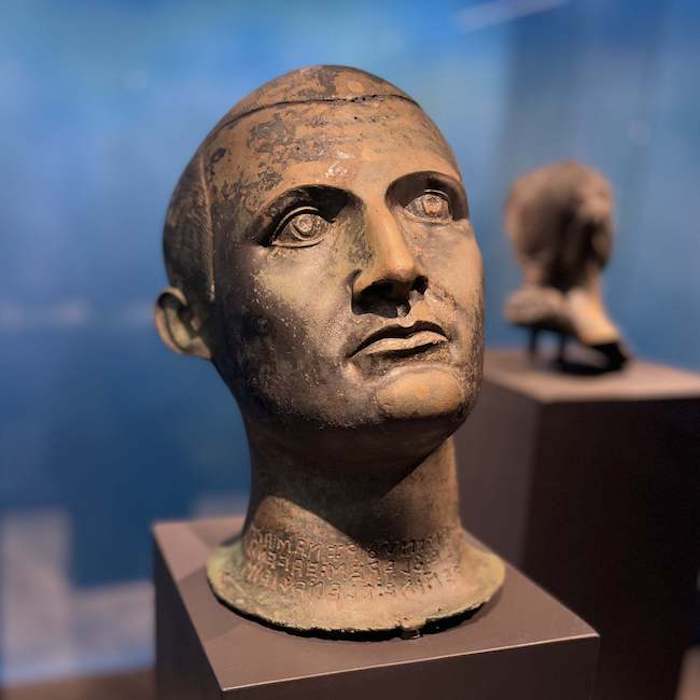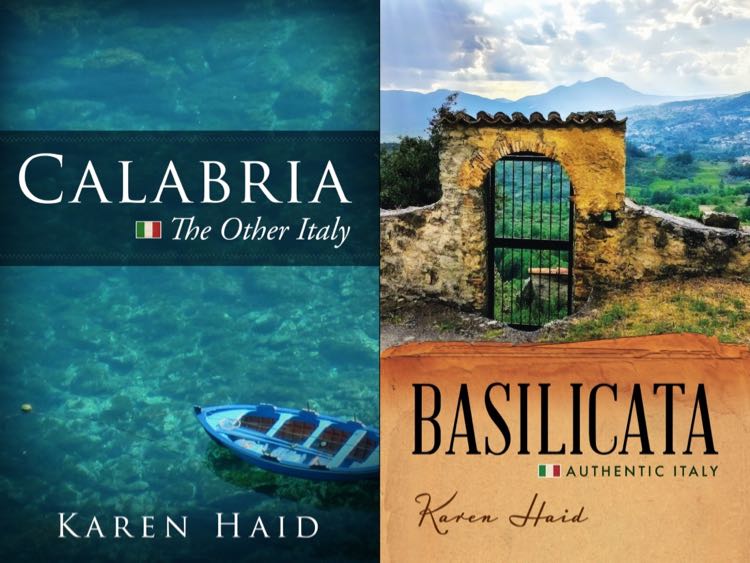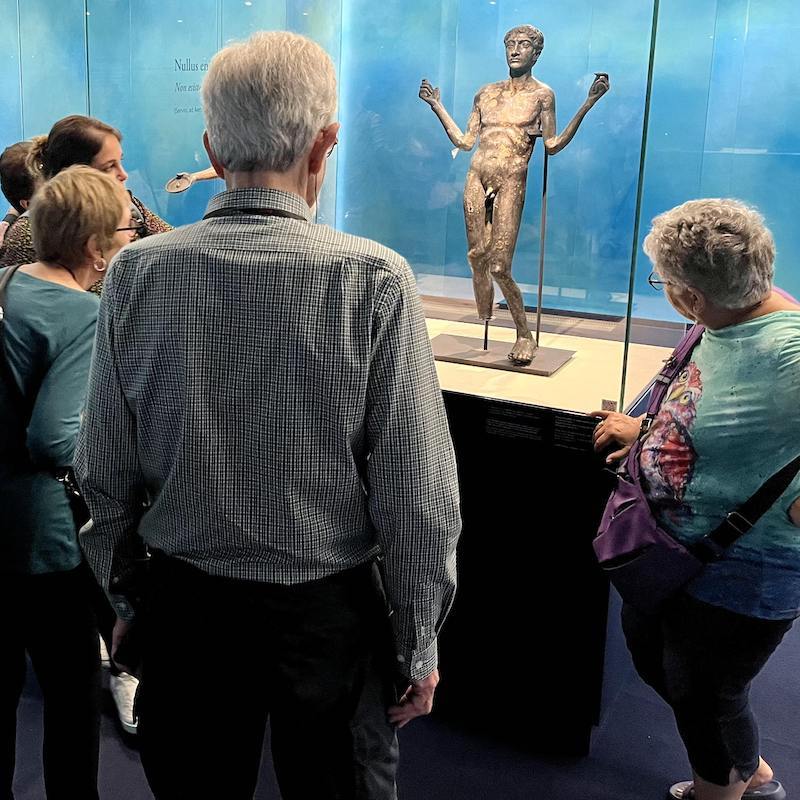A monumental discovery of Etruscan bronzes hit international headlines in the fall of 2022: Ancient statues pulled from the mud in Tuscan spa town! The Bronzes of San Casciano dei Bagni were immediately compared to the Bronzes of Riace, found off the coast of Calabria 50 years earlier.
ETRUSCAN, ROMAN AND GREEK BRONZES
Italians hail the Bronzes of San Casciano dei Bagni and those of Riace as the two greatest archeological discoveries of our time. Soon, the recently unearthed bronzes will have a new home in a museum being built especially for them in San Casciano dei Bagni, the spa town (and incidentally, one of the Borghi più belli d’Italia) in southeastern Tuscany where they were found.
In the meantime, they have been displayed at Rome’s Quirinal Palace and Naples’ archeological museum. This past summer, an exhibition of the statues was inaugurated at the archeological museum in Reggio Calabria, where I had the opportunity to admire them with guests on my Calabria tours, and where they’ll be on view through January 12, 2025.
ETRUSCANS AND ROMANS
What contributes to the excitement around the Bronzes of San Casciano dei Bagni is the context in which they were found. The statues, most of which date from the 2nd to the 1st century BC, were discovered in hot springs used by ancient Etruscans and Romans, and still frequented today. The area is one of the richest in thermal mineral waters in Italy. There are over 40 hot springs in San Casciano Valley, the largest of which, the Bagno Grande, puts forth 25 liters of water per second at a temperature above 40 degrees Celsius (104 F). For over 700 years, bronze and plant offerings were placed in this Great Bath, and the Etruscans built a sanctuary around the sacred pool.

Head sculpture with dedication to the Goddess of the Spring in Etruscan language around the neck, 1st century BC
Etruscans and then Romans visited the sanctuary and its waters in San Casciano from the 3rd-century BC to the 5th-century AD. The sacred pool, built of travertine blocks with a depth of over four meters (thirteen feet), was modified over time. Interestingly, many artifacts were found under a layer of terracotta tiles with a bronze thunderbolt, thought to be a ritual burial, as according to Etruscan tradition, sacred objects hit by lightning had to be buried.
The archeological site has given archeologists the opportunity to excavate artifacts in their original setting, presenting ancient rituals through the passage of time, from the Etruscans to the Romans. Chiusi, the city-state in whose territory San Casciano dei Bagni is located today, apparently experienced a more gradual Romanization compared with other areas in Etruria, as this toga-wearing Etruscan reflects. Perhaps thermal waters really do have a calming effect…
BRONZES OF SAN CASCIANO DEI BAGNI – MEDICINE
What first struck me upon seeing photos from the discovery were those of a rather unattractive statue, or better said, the image of a man unlike the more usual representations of ideal beauty in ancient statuary. In person, this unfortunate soul draws you in with his physical challenges, an unbalanced skeletal structure, bloated stomach, outreached, spindly arms with hands that appear unable to open, and a tortured expression. He is entitled “Male statue of sick ephebe”.
The Latin inscription on his right leg gives us detailed information about the “young man”: Lucius Marcius Grabillo, son of Lucius, this statue with another six and six legs from the foot to the inguinal in the Hot Springs, has freely fulfilled a worthy vow. This early 1st-century donation to the sanctuary speaks to us today, 2,000 years later. With this costly gift, the well-to-do young Roman entreats the gods for good health. Such body parts in bronze aren’t much different from the ex-votos in silver, wax, terracotta and other materials seen on the walls of churches today.
Curiously, healing was not just left to the sacred waters and the gods, as a surgical gouge was found together with representations of interiors, such as this bronze plaque from the first century with the dedication: to Fortune, Atimetus, administrator of Sulpicia Triaria, has freely discharged the well-deserved vow.
Other bronze pieces found in the sacred pool of the Bagno Grande include this grouping of a uterus, ears, eyes, breasts, penis and kidney dating from the 2nd-century BC to the 1st-century AD…
… and this swaddled infant from the 2nd-century BC.
BRONZES OF SAN CASCIANO DEI BAGNI – DONATIONS TO THE GODS
Apollo (Apulu in Etruscan), the god of healing and disease, was important for the sanctuary. In this 2nd-century-BC sculpture, also from the Bagno Grande, he is captured in motion, poised to shoot an arrow.
Another statue from the sacred pool depicts a woman in the act of praying.
This statue of a woman has a dedication to the Goddess of Spring in Etruscan on the front of her dress.
This male statue has his right arm in a sling.
There’s a timelessness to the two-dozen bronzes, amongst statues and body parts. Who doesn’t want to be cured? Man’s fragility was surely as palpable at an ancient sanctuary as it is at a state-of-the-art clinic today. Bathers in nearby pools, built later on by the Medicis, seek similar comforts as they slip down into the water. Others find solace at the town’s fancy spa hotels.
The sanctuary’s Etruscans and Romans should have been the lucky ones of their era, no doubt they soaked together harmoniously in the hot baths, hoping for a cure or simply enjoying the thermal waters on their skin. The ancient aristocrats sought well-being and gained an afterlife they would never have expected.
I was fortunate to have viewed these ancient Etruscan and Roman bronzes at the exhibition in Reggio. For idealized Greek beauty, join me in Calabria and check out the spectacular Bronzi di Riace on one of my small-group CALABRIA TOURS!
Read all about the fascinating Calabrian region in my book Calabria: The Other Italy, described by Publisher’s Weekly as “an intoxicating blend of humor, joy, and reverence for this area in Italy’s deep south,” and explore Calabria’s northern neighbor in my book Basilicata: Authentic Italy, “recommended to readers who appreciate all things Italian” by the Library Journal.
Follow me on social media: Basilicata Facebook page, Calabria: The Other Italy’s Facebook page, Karen’s Instagram and Karen’s Twitter for beautiful pictures and information.
Sign up below to receive the next blog post directly to your email for free.














Comments 3
Wow, it’s unusual to see deformity or people in poor health depicted from so long ago & it makes you think about the fact that people have had serious health issues since the beginning of time. It’s part of being human no matter when it was that you walked this earth. Kind of sobering…thanks for sharing, Karen
Author
Yes, and you have to figure that with life expectancy already being so low, what chance could someone already fighting the odds have had…?
A fascinating blog.
You make everything so understanable and interesting.
Somehow you manage to make events of thousands of years ago seem so very human and relevant to us today.
When are you doing your next small group tour?
Sign me up please!
Tava Daetz-Avarna
Duchessa di Gualtieri